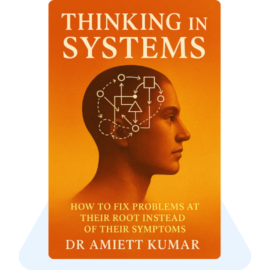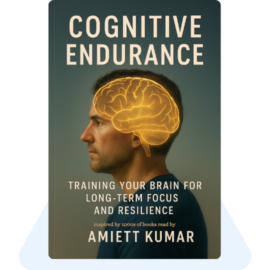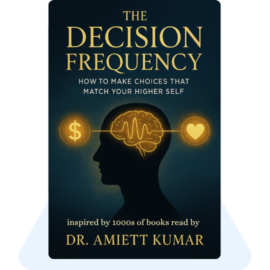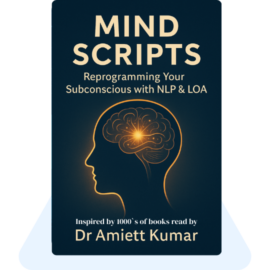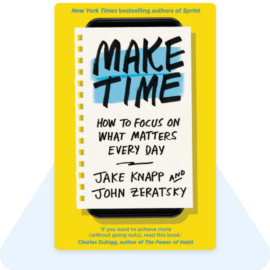Introduction — Why We Solve the Wrong Problem 80% of the Time
Most people don’t struggle because they face big problems.
They struggle because they apply small thinking to big systems.
We are conditioned to respond to symptoms — the immediate, visible, urgent signs:
- Feeling stressed → take a break
- Low productivity → work harder
- Business slowing → increase marketing
- Money issues → cut expenses
- Relationship conflict → talk more
- Weight gain → start a diet
These fixes give temporary relief…
…but the problem returns.
Sometimes stronger.
Why?
Because symptoms are loud, but root causes are silent.
Modern life is built on complex systems — feedback loops, hidden constraints, reinforcing patterns, and delayed effects.
But the human brain is wired for simple, fast, direct answers.
We look for linear logic in a nonlinear world.
This mismatch is why people stay stuck in cycles.
They try harder instead of thinking deeper.
They change actions instead of changing the structure that produces those actions.
Systems thinking gives you a superpower:
the ability to see invisible causes behind visible outcomes.
It transforms how you solve problems in:
• work
• career
• relationships
• finances
• habits
• business
• health
• decision-making
Once you understand that structure drives behavior, you stop reacting emotionally and start designing intelligently.
“When you change the system, you change the outcome — effortlessly and permanently.”
This book teaches you that clarity comes not from reacting faster, but from understanding deeper.
Not from more effort, but from better architecture.
Let’s begin.
Chapter 1 — What Is a System? Seeing the Invisible Structure Behind Every Problem
Before you can fix a system, you must learn to see it.
A system is not a thing — it’s a pattern.
It’s the invisible structure beneath every outcome in your life.
A system is made of three parts:
- Elements (the components)
- Interconnections (how the components affect each other)
- Purpose (the goal the system tries to achieve)
Think of your daily routine:
- Your energy
- Your sleep
- Your distractions
- Your environment
- Your habits
All interact.
Remove one, and the whole structure changes.
🧩 Why Systems Are Invisible
Because the human brain evolved to detect events, not patterns.
Events are clear, immediate, and emotional.
Systems are quiet, subtle, and cumulative.
Events:
- You overspend this month.
- You fought with your partner.
- You missed a workout.
System:
- No budgeting method
- Poor communication loops
- No consistent routine
The event is a symptom.
The system is the cause.
💡 Systems Produce Predictable Behavior
A powerful truth:
Systems are perfectly designed to produce the results you are getting.
If your:
- work is chaotic
- health is inconsistent
- finances are unpredictable
- relationships feel repetitive
- time slips away
…it’s because the system behind it is designed that way.
Not intentionally.
But by default.
🧠 Systems Create Patterns Automatically
For example:
A toxic workplace isn’t toxic because the people are bad, but because the reward loops, communication channels, and incentives reinforce certain behaviors.
A successful business isn’t successful because the founder is brilliant, but because the operating system enables consistent results.
Your life isn’t shaped by your goals —
it’s shaped by the systems that quietly run in the background.
“People don’t rise to the level of their goals; they fall to the level of their systems.”
Key Takeaway:
A system is not what you say you want — it’s what your structure produces.
If you want different results, redesign the structure, not the symptom.
Chapter 2 — Feedback Loops: The Real Forces Driving Behavior
Every system is powered by feedback loops — the hidden cycles that determine whether a system grows, stabilizes, collapses, or repeats.
There are two types:
1. Reinforcing Loops (Accelerators)
These loops amplify outcomes.
Small inputs → big outcomes.
Examples:
- Learning → better performance → more confidence → more learning
- Saving → more capital → more returns → more motivation
- Good communication → more trust → more openness → more communication
These loops create momentum.
This is how good systems become great.
But reinforcing loops also amplify negative patterns:
- Stress → poor sleep → lower performance → more stress
- Debt → interest → more debt
- Avoidance → problems grow → more avoidance
A reinforcing loop is a spiral — upward or downward.
2. Balancing Loops (Stabilizers)
These loops keep the system from going too far.
They create equilibrium.
Examples:
- Hunger → eat → reduce hunger
- Workload → fatigue → rest
- Demand → price increase → reduce demand
Balancing loops prevent the system from exploding — they maintain boundaries.
The Hidden Enemy: Delays
Delays make systems unpredictable.
When you take an action, the result doesn’t appear immediately.
This delay creates confusion and misinterpretation.
For example:
- Eating unhealthy shows no immediate impact
- Poor marketing doesn’t collapse a business overnight
- Saving money doesn’t feel rewarding instantly
- Trust builds slowly
- Skill compounding is invisible at first
The brain hates delays, so it reacts emotionally to short-term noise instead of long-term structure.
This is why we abandon good habits and cling to bad ones.
🧠 How Feedback Loops Influence Your Life
Career:
Skill development → better performance → more opportunities → deeper skill
(or the opposite spiral)
Health:
Good sleep → clarity → good decisions → better sleep
(or the opposite spiral)
Money:
Savings → compounding → confidence → more saving
(or debt spirals)
Relationships:
Appreciation → connection → better conversations
(or criticism loops → distance → more criticism)
🔥 Why Most People Misunderstand Loops
Because loops are invisible behaviors, not visible events.
You don’t feel a feedback loop — you notice it in results.
By the time you see the outcome, the loop has been running for months or years.
🧩 Breaking or Reinforcing Loops
The moment you change one link in a loop, the entire system redirects.
- Add one positive habit → the whole loop improves
- Remove one negative pattern → the downward spiral stops
- Insert one new rule → behavior reshapes
- Change one constraint → everything accelerates
“You don’t fix patterns by force — you fix them by fixing feedback.”
Key Takeaway:
Feedback loops determine the direction of your life.
Understand the loops, and you can predict — and design — your future outcomes.
Chapter 3 — Leverage Points: Small Changes That Create Big Results
Most people try to fix problems by pushing harder in the most visible areas.
But systems don’t change through force — they change through leverage points.
A leverage point is a place within a system where a small shift creates a massive impact.
Effort doesn’t matter.
Placement does.
🧠 Why We Miss Leverage Points
Because human intuition is trained to notice symptoms, not structure.
We try to fix what we see, not what causes what we see.
So people focus on:
- motivating themselves instead of redesigning habits
- hiring more instead of fixing workflow
- posting more content instead of improving strategy
- spending less instead of redesigning financial systems
- talking more in relationships instead of changing communication loops
These are low-leverage actions — exhausting but ineffective.
🎯 High-Leverage vs Low-Leverage Decisions
Low-Leverage:
Trying harder, pushing willpower, adding effort.
High-Leverage:
Redesigning rules, incentives, constraints, routines, or environment.
Example:
Instead of “trying to focus more,”
→ Design a system where your environment doesn’t allow distraction.
Instead of “trying to save more,”
→ Automate savings so you don’t rely on willpower.
🧩 How to Find Leverage Points
Look for:
- Bottlenecks
What is the one constraint holding everything back?
Fixing it often improves the entire system. - Feedback Loops
Where does a small change multiply over time? - Places Where Behavior Repeats
Recurring behaviors often indicate a structural cause. - Delays
Where are results slow to appear? Improving these areas compounds massively.
🔥 The Meadows Model (Simplified)
High-leverage points include:
- Changing goals
- Changing incentives
- Changing rules
- Changing access to information
- Changing beliefs that drive the system
- Designing new feedback loops
- Removing constraints
- Altering the environment
- Changing defaults
Even a 1% shift in a leverage point can reshape the entire system.
“Small changes don’t create big results — small changes in the right place do.”
Key Takeaway:
Don’t push the problem — redesign the structure.
The smartest moves in life are leverage-based, not effort-based.
Chapter 4 — Thinking in Patterns, Not Events
Events feel urgent.
Patterns feel invisible.
But it’s patterns — not moments — that create your life’s direction.
People who struggle react to events.
People who thrive respond to patterns.
🧠 Event Thinking = Short-Term Thinking
When something goes wrong, event thinkers ask:
- “What happened?”
- “Whose fault is it?”
- “How do I fix it right now?”
This mindset leads to firefighting, panic, and emotionally driven decisions.
🌊 Pattern Thinking = Long-Term Clarity
Pattern thinkers ask:
- “What keeps happening?”
- “What is the structure behind this?”
- “What loop is feeding this outcome?”
- “How long has this been building?”
This shift is what separates reactive people from strategic thinkers.
🔄 Patterns in Real Life
In productivity:
Event: You missed a deadline.
Pattern: You underestimate tasks by 30%.
In relationships:
Event: One fight.
Pattern: Avoiding difficult conversations.
In finances:
Event: Overspending this month.
Pattern: No budgeting or automation.
In health:
Event: Feeling tired today.
Pattern: Poor sleep consistency.
Events are symptoms.
Patterns are systems.
🛠️ Tools to Identify Patterns
- Look for repetition:
If it happens often, it’s not an accident — it’s a system. - Zoom out the timeline:
Patterns reveal themselves across weeks, months, years. - Track behavior, not feelings:
Emotions lie — data doesn’t. - Name your loops:
“Stress-avoidance loop,” “overcommitment loop,” “distraction loop.”
Naming a pattern helps you break it.
💡 The Power of Pattern Recognition
Once you notice a pattern, you reduce emotional overreaction.
You stop blaming luck.
You stop repeating mistakes.
You become calm, analytical, strategic.
“The event is noise. The pattern is the truth.”
Key Takeaway:
When you stop reacting to events and start studying patterns, you stop solving the wrong problems — and start solving the real ones.
Chapter 5 — The Problem with Linear Thinking in a Nonlinear World
Humans are wired for linear thinking:
If A happens, then B happens.
If B happens, then C happens.
Simple. Predictable.
But the world doesn’t work that way.
Life is nonlinear —
actions multiply, ripple, escalate, compound, and echo back.
🧠 Why Linear Thinking Fails
Linear thinking assumes:
- progress is steady
- results are proportional
- cause and effect are close in time
- simple actions create simple reactions
But in systems, cause and effect are often distant in time and space.
For example:
- Bad sleep today affects productivity next week
- A marketing mistake shows its damage 3 months later
- Compounding investments accelerate after years
- Trust is built slowly but lost instantly
- Stress accumulates invisibly until a breakdown
Linear thinking blinds you to exponential effects.
🌪️ Nonlinear Thinking: Seeing Beyond the Obvious
Nonlinear thinkers understand:
- small habits → massive results over time
- early decisions → long-term consequences
- small errors → exponential fallout
- improving systems → exponential upside
They think “If I change this ONE thing, what will happen over the next 100 days?”
🧩 Mental Models That Help You Think Nonlinearly
- Second-Order Thinking
Not “What happens if I do this?”
But “What happens after what happens?” - Compounding
Results accelerate, then explode. - Tipping Points
Change appears tiny until it suddenly becomes massive. - Unintended Consequences
Every decision creates effects you didn’t plan for. - Lag and Lead Indicators
Lead indicators → cause
Lag indicators → effect
🔥 Real-World Examples
- Investing:
Tiny consistent investments → exponential returns later. - Business:
A small customer experience flaw → viral complaints → brand damage. - Habits:
A 1% daily improvement → radical life shift in a year. - Health:
Years of good choices → strong immunity, high energy.
Years of bad choices → sudden disaster.
💡 The Mindset Shift
Linear thinkers try to predict the next step.
Systems thinkers predict the next 20 steps.
Linear thinkers react to what’s visible.
Systems thinkers prepare for what’s coming.
“The world punishes linear thinkers. It rewards those who understand compounding, loops, and ripple effects.”
Key Takeaway:
Life is nonlinear — but your thinking doesn’t have to be.
When you anticipate ripple effects and compounding outcomes, your decisions become dramatically more effective.
Chapter 6 — System Traps: Why Good Intentions Create Bad Outcomes
Even smart people fall into the same predictable system traps — because traps are built into the structure, not the person.
These traps make solutions backfire, create new problems, or make old problems worse.
Understanding them is the key to avoiding repeated frustration.
1. Fixes That Fail
A quick fix works instantly but worsens the problem long-term.
Examples:
- Using caffeine to “fix” exhaustion
- Discounting to “fix” slow sales
- Motivating yourself to “fix” consistency
- Talking more to “fix” relationship conflict
- Hiring more people to “fix” workflow chaos
Short-term relief → deeper long-term damage.
Why it happens:
The fix treats the symptom, which then grows once the fix wears off.
2. Shifting the Burden
Blaming an external source instead of fixing the internal loop.
Examples:
- Blaming the market instead of refining strategy
- Blaming clients instead of optimizing delivery
- Blaming employees instead of improving processes
- Blaming time instead of changing priorities
The burden shifts outward → the real system never changes.
3. Drifting Goals
When small compromises slowly weaken standards.
Examples:
- “I’ll skip the gym today” → becomes 10 skipped days
- “This quality is okay for now” → drops standards
- “We’ll fix this process later” → process never gets fixed
The system unconsciously lowers expectations.
4. Rule Beating
People follow the rule but break the purpose.
Examples:
- Teams hitting metrics while damaging quality
- Students passing exams without learning
- Employees appearing busy but not productive
- Companies meeting deadlines but producing poor work
Compliance replaces effectiveness.
5. Escalation
Two sides responding to each other’s actions → creating a spiral.
Examples:
- Price wars in markets
- Emotional escalation in relationships
- Competitive overspending among peers
The system accelerates conflict.
🛠️ How to Escape System Traps
- Identify the loop, not the event
- Redesign incentives & defaults
- Raise standards consciously
- Remove the need for rule-beating
- Introduce buffers & cooldown mechanisms
- Create feedback systems that correct automatically
“System traps aren’t human failures — they’re structural failures.”
Key Takeaway:
If you keep falling into the same trap, your system needs redesigning, not your willpower.
Chapter 7 — Designing Better Systems for Productivity, Work, and Life
Great results don’t come from motivation — they come from well-designed systems that run even when motivation is low.
A well-designed system makes good choices easy and bad choices difficult.
1. Productivity Systems
Structure > discipline.
Design for:
- Focus cycles instead of long hours
- No-sync morning routines (no meetings or calls early)
- Environment with zero friction (clean desk, blocked distractions)
- Task batching instead of context switching
- Weekly reviews instead of firefighting
These systems reduce decision fatigue and increase clarity.
2. Habit Systems
Habits don’t need willpower — they need architecture.
- Make good behaviors obvious, easy, rewarding
- Make bad behaviors hidden, hard, inconvenient
- Use triggers (same time, same place)
- Automate routines whenever possible
Behavior follows design.
3. Financial Systems
Don’t rely on emotional decisions.
Create systems:
- Automate saving
- Automate investing
- Automate bills
- Predefine spending categories
- Charge a penalty for breaking rules
- Remove “randomness” from money decisions
Systems eliminate emotional bias.
4. Relationship Systems
Healthy relationships run on small rituals, not big talks.
Examples:
- Daily check-ins
- Weekly clarity conversations
- Shared expectations
- Pre-agreed conflict rules
- Appreciation loops
Systems reduce unnecessary fights and emotional spikes.
5. Business Systems
Businesses fail not from bad ideas, but from bad systems.
Design for:
- Clear workflows
- Roles and responsibilities
- Feedback loops
- Constraints awareness
- Predictable processes
- Outcome tracking
A business is only as strong as its systems, not its founder.
“Systems are self-care for your future self.”
Key Takeaway:
When you design smart systems, you remove dependence on motivation — and life becomes smoother, predictable, and consistently progressive.
Chapter 8 — The Systems Mindset: Thinking “Upstream” Instead of Downstream
Most people solve problems only after they explode.
Systems thinkers solve them before they exist.
This is called Upstream Thinking — looking for the root cause several steps earlier in the system.
🚧 Downstream Thinking
- Reacting
- Firefighting
- Emotional decisions
- Short-term relief
- Solving the obvious problem
Examples:
• Fixing burnout instead of fixing workload
• Fixing overspending instead of fixing impulsive triggers
• Fixing conflicts instead of fixing communication loops
• Fixing lost sales instead of fixing lead quality
This is why problems repeat.
🚀 Upstream Thinking
Upstream thinkers ask:
- “What created this?”
- “What’s the earliest point where this could be prevented?”
- “What system allowed this to happen?”
- “What pattern is repeating?”
This makes problems:
- smaller
- cheaper
- fewer
- predictable
- preventable
🔍 Tools for Upstream Thinking
1. Root Cause Analysis (The 5 Whys)
Ask “Why?” five times until you reach the real cause.
2. Constraint Identification (Theory of Constraints)
Find the one bottleneck limiting the entire system.
3. Leading vs Lagging Indicators
Lagging = the result
Leading = the cause
Systems thinkers focus on leading indicators.
4. Pre-Mortem Thinking
“Imagine this failed. What caused it?”
Then fix those causes upfront.
5. Design for Prevention, Not Correction
It’s better to build stable systems than heroic rescue routines.
🌱 The Mental Shift
This mindset rewires your thinking:
- from urgency → to strategy
- from reaction → to anticipation
- from noise → to structure
- from control → to design
- from temporary relief → to structural change
Upstream thinkers rarely face crises — because the system prevents them.
“Solve problems when they’re tiny and invisible — not when they’re loud and expensive.”
Key Takeaway:
Upstream thinking saves time, energy, money, and peace.
It turns you into the architect of outcomes rather than the victim of symptoms.
Chapter 9 — Becoming a Systems Thinker: Daily Practices to Improve Clarity
Systems thinking isn’t a talent.
It’s a discipline — a way of seeing the world that strengthens with practice.
The goal is not to think more.
It’s to think wiser, with less emotional noise and more structural awareness.
Here are the core practices that train your mind to think in systems:
1. Slow Down Your Thinking
Fast thinking reacts.
Slow thinking observes.
Pause before acting.
Ask:
- “What system produced this?”
- “What might this lead to over time?”
- “What’s the pattern behind this event?”
Slowing down interrupts emotional loops and reveals structural ones.
2. Map Cause-and-Effect Loops
Instead of thinking A → B…
Start mapping A → B → C → A.
Most problems are circular, not linear.
Example:
Stress → bad sleep → lower productivity → more stress
= feedback loop
Visualizing loops clarifies where interventions should go.
3. Identify Constraints
Every system is limited by a single bottleneck.
Ask:
“What is the ONE constraint that limits progress?”
Fix that, and the entire system accelerates.
This is the 80/20 of systems thinking.
4. Use “If-Then-Next” Thinking
Not just “What happens if I do this?”
But:
- “What happens after that?”
- “And after that?”
- “And after that?”
This breaks linear thinking and reveals ripple effects.
5. Track Patterns, Not Feelings
Feelings distort reality.
Data exposes it.
Track:
- behaviors
- timelines
- recurring issues
- energy cycles
- performance trends
- system outputs
Patterns tell the truth your emotions hide.
6. Redesign Environments, Not Willpower
Systems thinkers don’t fight temptation — they eliminate it.
They don’t rely on discipline — they engineer it.
They design spaces, routines, and defaults to reduce chaos and amplify clarity.
7. Build Self-Correcting Systems
A good system doesn’t need constant attention.
It runs itself.
Good examples:
- Automated savings
- Weekly planning rituals
- Communication rules
- Pre-set priorities
- Standard operating procedures
Design systems that adjust automatically when something goes off track.
8. Practice “Zoom In, Zoom Out” Thinking
Zoom In = analyze details
Zoom Out = see big picture
Moving between these two perspectives prevents overreaction and ensures clarity.
9. Reflect Weekly: What Worked? What Didn’t? Why?
Reflection converts experience into insight.
Without reflection, you repeat the same loops.
Ask weekly:
- What patterns showed up?
- What systems helped me?
- What systems failed me?
- What will I adjust this week?
Reflection is the maintenance that keeps systems optimized.
“Thinking in systems isn’t complicated — it’s consistent.
Small questions create big clarity.”
Key Takeaway:
Systems thinking becomes natural when you practice slowing down, mapping loops, identifying constraints, and redesigning structure.
With these habits, clarity stops being accidental — it becomes automatic.
Conclusion — When You Change the System, You Change the Outcome
Most people spend their lives solving the wrong problems:
fighting symptoms, reacting emotionally, chasing short-term relief.
But symptoms are just signals.
They’re not the real problem — the system is.
Systems control behavior.
Systems shape habits.
Systems determine results.
Systems influence relationships.
Systems govern finances.
Systems drive performance.
Systems create outcomes.
When the system is flawed, effort feels exhausting.
When the system is designed well, progress feels effortless.
➤ The most powerful truth you’ve learned in this book:
Your outcomes are not created by your intentions.
They are created by the structure you operate within.
Once you shift from asking,
“What happened?”
to
“What system produced this?”
your entire life changes.
🌱 Systems Thinking Creates Freedom
You stop firefighting and start designing.
You stop reacting and start anticipating.
You stop forcing willpower and start engineering behavior.
You stop blaming luck and start mastering structure.
🧠 The Real Advantage
The world is complex.
Most people get overwhelmed.
A systems thinker stays calm because they see patterns others miss.
They understand:
- every event has a loop beneath it
- every loop has a cause
- every cause can be redesigned
- every redesign improves outcomes
This clarity is rare.
And it’s powerful.
🔧 Your Future Is a System
Your productivity is a system.
Your relationships are systems.
Your creativity, money, time, energy — all systems.
If you fix the system once,
you stop fixing the problem repeatedly.
That is how real, lasting change happens.
“Great lives aren’t built on effort.
They’re built on intelligent systems.”
When you change your structure,
you change your trajectory.
You create a life that works — not by accident, but by design.
Learn More from Dr Amiett Kumar:
The Science of Chakras: How Energy Centers Shape Your Emotions and Reality
Contents

